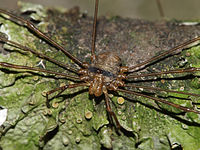
Photo from wikipedia
Spider mites (Acari: Tetranychidae) include serious agricultural pests and some species have spread globally as invasive species.. For this reason, rapid and simple identification of spider mite species is necessary… Click to show full abstract
Spider mites (Acari: Tetranychidae) include serious agricultural pests and some species have spread globally as invasive species.. For this reason, rapid and simple identification of spider mite species is necessary for agricultural field and plant quarantine inspection. DNA sequence-based molecular techniques can rapidly identify spider mites. However, extracting DNA from minute invertebrates is difficult, expensive and time consuming. Here, we describe a polymerase chain reaction (PCR) technique in which the whole body of a spider mite adult is non-destructively soaked in PCR solution. The mite is then removed intact and can be used as a voucher specimen, leaving the PCR solution as the template and avoiding the need for a DNA extraction kit. For this study, we used six common spider mite species from four genera [Tetranychus urticae Koch (red form), Tetranychus kanzawai Kishida, Tetranychus parakanzawai Ehara, Oligonychus gotohi Ehara, Eotetranychus smithi Pritchard & Baker and Panonychus citri (McGregor)]. A portion of the mitochondrial cytochrome c oxidase subunit I (COI) gene was amplified with a universal primer pair from all individuals examined and sequenced. This method shortened the time for molecular identification from 9 to 5 h and eliminated the cost of commercial kits for DNA extraction [ca. 600 yen (~5.3 USD) per sample].
Journal Title: Applied Entomology and Zoology
Year Published: 2017
Link to full text (if available)
Share on Social Media: Sign Up to like & get
recommendations!